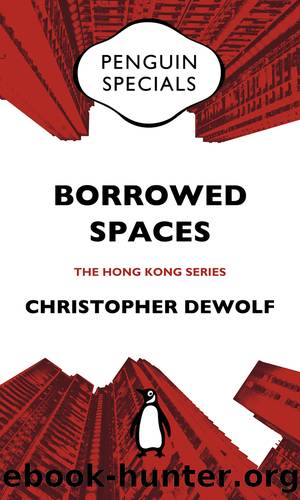Borrowed Spaces by Christopher DeWolf

Author:Christopher DeWolf
Language: eng
Format: epub
Tags: Non-Fictiom
ISBN: 9781760143978
Publisher: Penguin Random House Australia
Build Your Own City
Walking through Hong Kong raises my blood pressure. Iâm a dedicated pedestrian; given the choice, I prefer to walk. Considering that less than 10 per cent of Hong Kongâs population get around by car, you would think Iâd be in good company, yet the streets here are anything but pedestrian-friendly. There are few trees and even fewer benches. Roadside fences pen you into narrow, overcrowded sidewalks, lest you dash into the street and get in the way of the Toyota Alphard minivans beloved by the chauffeured class. There are plenty of small parks, plazas and âsitting-out areasâ â a quaintly named variety of gated public space that usually consists of a few benches and some shrubs â but many of them are poorly designed. One sitting-out area on Queenâs Road East consists of two benches and a patch of concrete surrounded by a wall.
On paper, Hong Kong has a lot of public open spaces, but they arenât quality spaces. You get the sense that most of the cityâs public outdoor areas exist to tick boxes on somebodyâs checklist; they arenât designed for people to actually gather and chat, or lie down for a quick lunchtime nap. If you arenât sitting rigidly on a bench, staring straight ahead, these spaces arenât for you.
Serbian architect Selena Savic calls this kind of thing âunpleasant designâ. In an interview with the South China Morning Post, she said it ârefers to things that are intentionally and successfully rendered unusable, or uncomfortable for people to use. Itâs not about objects that are badly designed, but the opposite â objects, devices and spaces that are well designed in order to prohibit a particular use or behaviourâ.20 In other words, itâs a form of social control. Design a bad bench so homeless people donât linger; fence off your sitting-out area so people donât spend too much time there.
In more suburban places, this hostile architecture has contributed to a decline of the commons, as more and more people spend their time in private spaces. But Hong Kongers donât have that kind of luxury; they need an outlet from their tiny apartments. So they make their own space.
In a quiet alleyway behind Hollywood Road, a group of old men gather around folding tables to play cards and Chinese chess. Listening to the radio â Cantonese opera on weekdays, horse races on Sunday â they sit on threadbare office recliners, second-hand stools, worn wooden dining chairs. At night, the wail of opera gives way to boozy laughter as this makeshift living room is taken over by patrons from Club 71, an adjacent bar named for the annual pro-democracy march. Itâs time-shared urban space.
This isnât anything deliberate; the people who use these borrowed spaces donât pay them much thought. Itâs just a pragmatic response to an uncomfortable urban environment. In Hong Kong, the line between public and private space has always been blurry. Shops spill onto the streets like overflowing Aladdinâs caves. Someone places an altar beneath a tree and it grows into a neighbourhood shrine.
Download
This site does not store any files on its server. We only index and link to content provided by other sites. Please contact the content providers to delete copyright contents if any and email us, we'll remove relevant links or contents immediately.
Kathy Andrews Collection by Kathy Andrews(11767)
The remains of the day by Kazuo Ishiguro(8896)
Paper Towns by Green John(5142)
Spare by Prince Harry The Duke of Sussex(5142)
The Body: A Guide for Occupants by Bill Bryson(5033)
Industrial Automation from Scratch: A hands-on guide to using sensors, actuators, PLCs, HMIs, and SCADA to automate industrial processes by Olushola Akande(5027)
Machine Learning at Scale with H2O by Gregory Keys | David Whiting(4262)
Be in a Treehouse by Pete Nelson(3999)
Never by Ken Follett(3885)
Harry Potter and the Goblet Of Fire by J.K. Rowling(3810)
Goodbye Paradise(3767)
Into Thin Air by Jon Krakauer(3350)
The Remains of the Day by Kazuo Ishiguro(3349)
Fairy Tale by Stephen King(3311)
The Cellar by Natasha Preston(3299)
The Genius of Japanese Carpentry by Azby Brown(3256)
120 Days of Sodom by Marquis de Sade(3229)
The Man Who Died Twice by Richard Osman(3042)
Drawing Shortcuts: Developing Quick Drawing Skills Using Today's Technology by Leggitt Jim(3040)
